This guide initially displays common trees of all shapes. Use the selectors below to view particular shapes, include rare species, or search by name.
Growth of trees in the Southwest largely depends on temperature and moisture. In general, temperature is lower at higher altitudes, moisture is greater. As altitude affects temperature and moisture, it largely determines the distribution of tree species in this area.
Los Alamos County and surrounding areas include three main vegetation zones. The Pinyon-Juniper Woodland (4500 – 7500 ft; 1375 – 2300 m) is characterized by pinyon pine, one-seed juniper, alligator juniper and Rocky Mountain juniper. The Ponderosa Pine Forest (5500 – 8500 ft; 1700 – 2600 m) consists mainly of ponderosa pine. The Spruce-Fir Forest (8000 – 12000 ft; 2500 – 3650 m) includes Douglas fir, white fir, quaking aspen, limber pine, and, at higher altitudes, Engelmann spruce and subalpine fir. Little (Southwestern Trees: A Guide to Native Species in New Mexico and Arizona [PDF]) describes these zones in more detail.
Two recent catastrophic wildfires (Cerro Grande Fire in 2000, Las Conchas Fire in 2011) burned large areas of Los Alamos County. The burned areas now support fast-growing pioneer species rather than the slow-growing trees that characterize the vegetation zones. What was Pinyon-Juniper Woodland is now largely grassland; what was Ponderosa Pine Forest is now largely grass, Gambel oak, and quaking aspen; what was Spruce-Fir Forest is now largely grass and quaking aspen. Vegetation in these areas will change as succession proceeds.
This guide describes many of the native species of trees in and around Los Alamos County. It also includes a few introduced species that are often seen in the wild. More detailed information can be found in Plants of the Jemez Mountains Volume 1, which is available in the PEEC gift shop.
Tree References
American Trees – Big Trees Project
Arbor Day Foundation
Kershner, B, Mathews, D, Nelson, G, Spellenberg, R, 2008
National Wildlife Federation Field Guide to Trees of North America.
Sterling Publishing Company
Sibley. D.A., 2009 The Sibley Guide to Trees. Alfred A. Knopf, Inc.
Flora of North America
Encyclopedia of Life
Lady Bird Johnson Wildflower Center
SEINet
Spellenberg, R., Earle, C.J., Nelson, G., 2014 Trees of Western North America.
Princeton University Press
Southwestern Trees: A Guide to Native Species in New Mexico and Arizona, 1968
Agriculture Handbook No. 9, United States Department of Agriculture [PDF]
Foxx, T., Martin, C., and Hoard, D., 2016 Plants of the Jemez Mountains Volume 1:
Tree, Shrubs, Vines, Ferns, and Horsetails. All Seasons Publishing
US Department of Agriculture National Resources Conservation Services
Subject Area Experts (all guides)
Steve Cary (butterflies)
Beth Cortright (insects)
Terry Foxx (invasive plants)
Leslie Hansen (mammals)
Richard Hansen (fish, mammals)
Dorothy Hoard (butterflies, trees)
Chick Keller (flowers, herbarium)
Shari Kelley (geology)
Kirt Kempter (geology)
Garth Tietjen (reptiles)
David Yeamans (birds)
Web Development and Content Management
Pat Bacha
Jennifer Macke
Graham Mark
Akkana Peck
Contact
Please contact us for local nature questions and sightings. We welcome comments, corrections, and additions to our guides.
For more information about local nature, please visit our Nature Blog or subscribe to PEEC This Week.
Make Selection
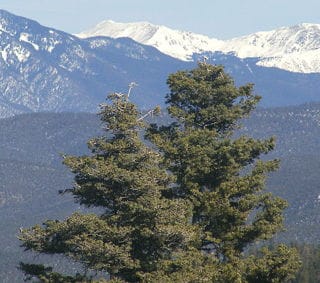 Photo: David Herrera 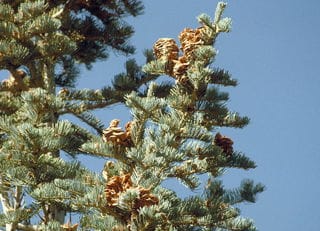 Photo: David Powell |  White FirABCO (Abies concolor)Family: Pinaceae (Conifer - Pines) Size: 70 - 160 ft (25 - 50 m) Growth: tree; perennial Status: native; common Habitat: moist, rocky soils at elevations of 5,500 to 11,000 ft (1,700 to 3,400 m) This tree is popular as an ornamental and Christmas tree. It has a narrow crown appearing almost spire-like. The branches are short. Info Photos Range Distribution |
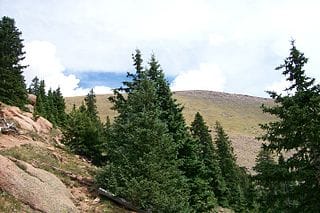 Photo: Jeremiah LaRocco 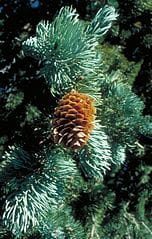 Photo: Dave Powell |  Englemann Spruce, Mountain Spruce, Silver SprucePIEN (Picea engelmannii)Family: Pinaceae (Pines) Size: 80 - 100 ft (25 - 30 m) Growth: tree; perennial Status: native; common Habitat: moist areas, often dominant subalpine fir at elevations up to 8,000 to 12,000 ft (2,400 to 3,600 m) Harvested for paper and general construction, as well as being used as a Christmas tree. It has dark blue-green foliage on drooping, horizontal branches. Info Photos Range Distribution |
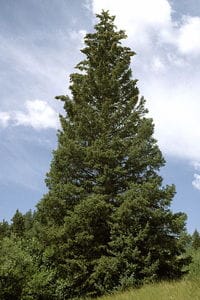 Photo: Jeffrey J. Witcosky 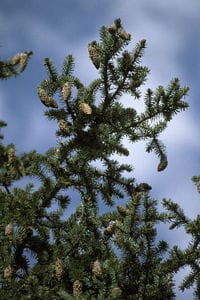 Photo: Jeffrey J. Witcosky |  Colorado Blue SprucePIPU (Picea pungens)Family: Pinaceae (Pines) Size: 15 - 30 ft (5 - 10 m) Growth: tree; perennial Status: native; common Habitat: dry areas, often in stands at elevations of 6,000 to 11,000 ft (1,800 to 3,400 m) Pyramidal tree with stiff horizontal branches. It becomes more cylindrical as it gets older. The bark is thin, gray, and scaly. Info Photos Range Distribution |
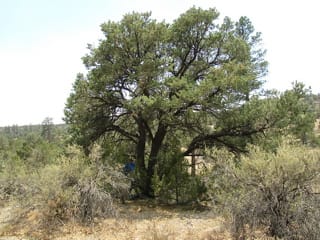 Photo: Dorothy Hoard 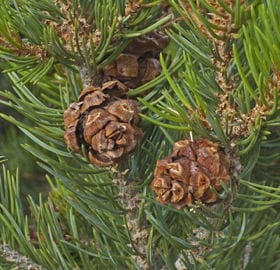 Photo: snowpeak |  Colorado Pinyon Pine, Two-needle Pinyon, Pinyon PinePIED (Pinus edulis)Family: Pinaceae (Pines) Size: 15 - 35 ft (5 - 15 m) Growth: tree; perennial Status: native; common Habitat: alone or with junipers on mesas and lower mountain slopes; at elevations of 5,000 to 7,000 ft (1,500 to 2,100 m) This is a low bushy tree with paired needles. The cones bear edible pine nuts consumed by a variety of animals and birds. Info Photos Range Distribution |
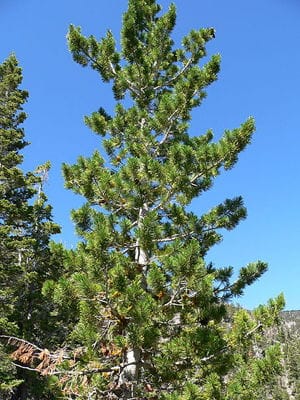 Photo: Stan Shebs 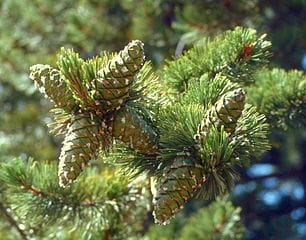 Photo: Dave Powell |  Limber Pine, Rocky Mountain White PinePIFL2 (Pinus flexilis)Family: Pinaceae (Pines) Size: 35 - 55 ft (15 - 20 m) Growth: tree; perennial Status: native; common Habitat: dry, rocky slopes and ridges at elevations from 5,000 to 12,000 ft (1,500 to 3,700 m) Often has an irregular, contorted or multi-stemmed trunk. Bark is scaly with ridges. Its nuts are a high energy food for a variety of animals. Info Photos Range Distribution |
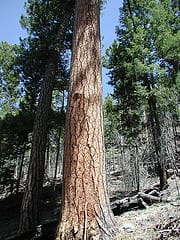 Photo: Dorothy Hoard 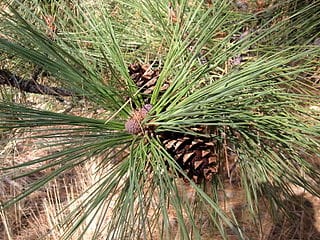 Photo: Walter Siegmund |  Ponderosa Pine, Blackjack Pine, Western Yellow PinePIPO (Pinus ponderosa)Family: Pinaceae (Pines) Size: 60 - 130 ft (20 - 40 m) Growth: tree; perennial Status: native; common Habitat: pure stands, often forming extensive forests at elevations of 4,000 to 8,000 ft (1,200 to 2,400 m) The Ponderosa Pine is very tall with a conical crown and many spreading branches. Bark is orange with broad, irregular scaly-plates. Info Photos Range Distribution |
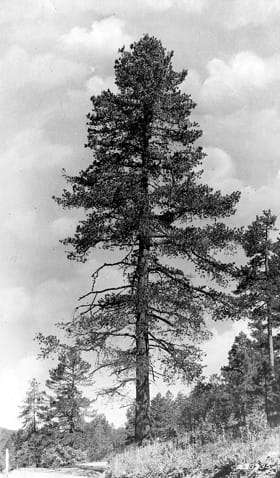 Photo: USDA-NRCS PLANTS Database 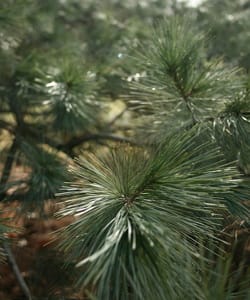 Photo: Beth Burdick |  Southwestern White Pine, Chihuahua White PinePIST3 (Pinus strobiformis)Family: Pinaceae (Pines) Size: 50 - 80 ft (15 - 25 m) Growth: tree; perennial Status: native; common Habitat: dry, rocky slopes at elevations of 6,500 to 10,000 ft (2,000 to 3,000 m) Has an open, irregular crown and straight trunk. The branches are long and horizontal. The northern range of the Southwestern White Pine overlaps with that of Limber Pine. The two can hybridize making it very difficult to identify a true Southwestern White Pine. Info Photos Range Distribution |
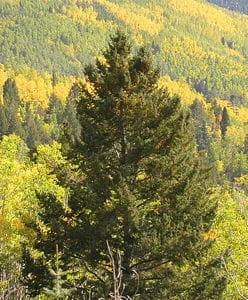 Photo: Bryan Ungard 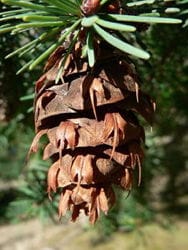 Photo: Walter Siegmund |  Douglas-fir, Oregon Pine, Douglas-sprucePSME (Pseudotsuga menziesii)Family: Pinaceae (Pines) Size: 80 - 200 ft (25 - 60 m) Growth: tree; perennial Status: native; common Habitat: rocky soil on mountain slopes, often in pure stands at elevations of 8,000 to 9,500 ft (2,400 to 2,900 m) This tree yields more timber than any other tree in North America. Its seeds are important as food for a large number of birds. The local trees are know as the “blue” variety. Info Photos Range Distribution |
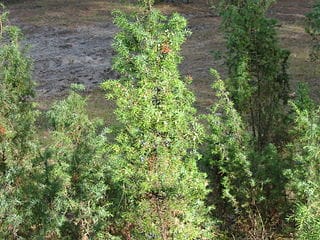 Photo: Krzysztof P. Jasiutowicz 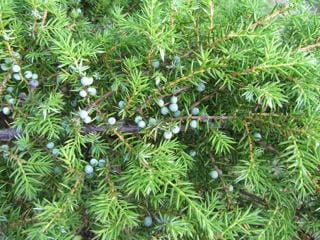 Photo: Homer Edward Price |  Common JuniperJUCO6 (Juniperus communis)Family: Cupressaceae (Cypresses) Size: 3 - 6 ft (1 - 2 m) Growth: shrub, tree; perennial Status: native; common Habitat: rocky slopes in mountain forests at elevations of 8,000 to 11,500 ft (2,400 to 3,500 m) Usually seen as a spreading low shrub, occasionally as a small tree with open irregular crown. This species has the most extensive native range of any North American conifer. Its seed cones are used to flavor gin. Info Photos Range Distribution |
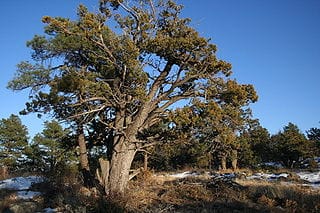 Photo: cogdogblog 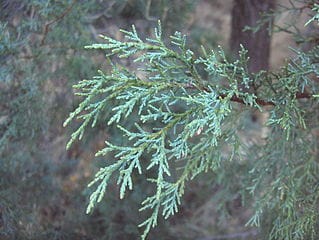 Photo: Homer Edward Price 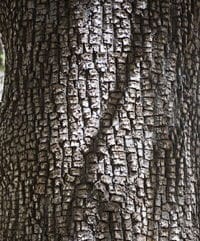 Photo: Kretyen |  Alligator Juniper, Checkerbark JuniperJUDE2 (Juniperus deppeana)Family: Cupressaceae (Cypresses) Size: 20 - 50 ft (10 - 15 m) Growth: shrub, tree; perennial Status: native; locally common Habitat: rocky hillsides with pinyons and other junipers at elevations of 4,500 to 8,000 ft (1,400 to 2,400 m) The bark is very distinctive with cracks that form small square plates resembling alligator skin. Foliage is bluish-gray or green with a white resin spot. Info Photos Range Distribution |
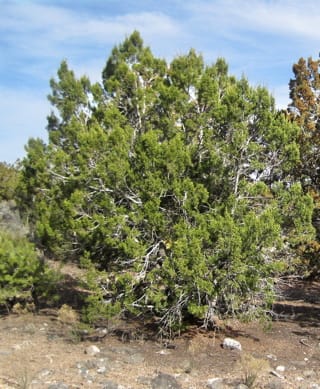 Photo: Akkana Peck 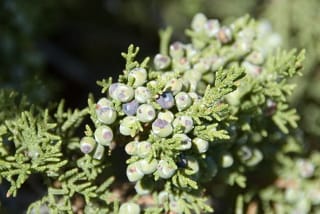 Photo: Paul Asman and Jill Lenoble |  Oneseed Juniper, New Mexico Cedar, Cherrystone JuniperJUMO (Juniperus monosperma)Family: Cupressaceae (Cypresses) Size: 10 - 25 ft (3 - 8 m) Growth: shrub, tree; perennial Status: native; common Habitat: rocky soils in pure stands at elevations of 3,000 to 7,000 ft (900 to 2,100 m) This is a small tree with a dense, rounded crown. Juvenile leaves are more needle-like than scale-like. Its wood is not very durable. Info Photos Range Distribution |
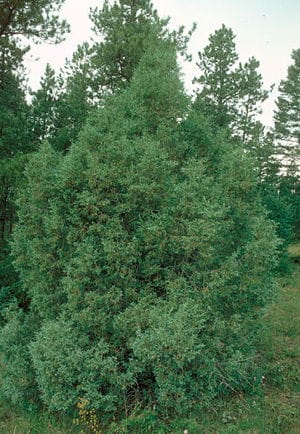 Photo: David Powell 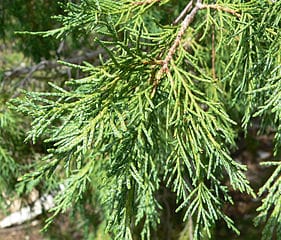 Photo: Stan Shebs |  Rocky Mountain JuniperJUSC2 (Juniperus scopulorum)Family: Cupressaceae (Cypresses) Size: 20 - 50 ft (10 - 15 m) Growth: shrub, tree; perennial Status: native; common Habitat: limestone and lava outcrops, in foothills with pinyons at elevations of 5,000 to 9,000 ft (1,500 to 2,800 m) This is a very long-lived species (2,000 years or more) that can be harvested for its wood and potentially berries. Its foliage is arranged in sweeping arrays. Info Photos Range Distribution |
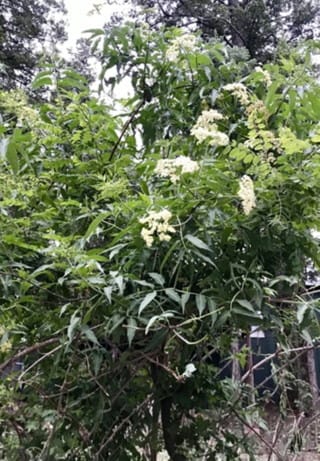 Photo: CK Kelly 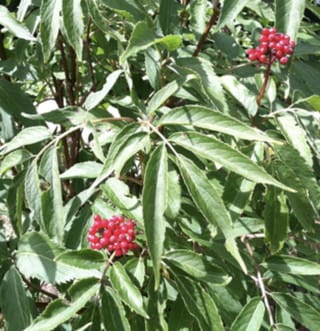 Photo: Cullen Hanks |  Red Elderberry, Red Elder, Red-berried ElderSARA2 (Sambucus racemosa)Family: Adoxaceae (Moschatel) Size: up to 20 ft (10 m) Growth: shrub, tree; perennial Status: native; locally common Habitat: woodland, wet meadow, prairie and field The elderberry grows as a shrub in clumps and occasionally as a small tree. The flowers are small and white; berries bright red. Both the flowers and berries have an unpleasant odor when crushed. Info Photos Range Distribution Flower Guide |
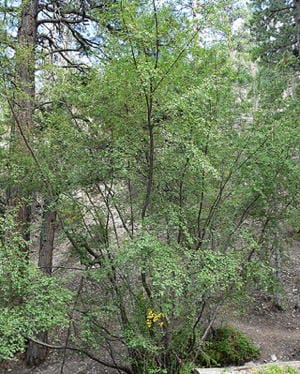 Photo: Stan Shebs 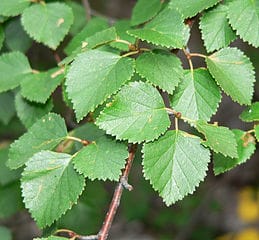 Photo: Stan Shebs |  Water Birch, Red BirchBEOC2 (Betula occidentalis)Family: Betulaceae (Birches) Size: up to 20 ft (10 m) Growth: shrub, tree; perennial Status: native; common Habitat: along streams in mountainous regions There is a strong tendency to have many small limbs sprouting from the trunk. This causes the wood to be full of small knots. The fruit is long, broad and comprised of tiny seeds packed in between bracts. Info Photos Range Distribution |
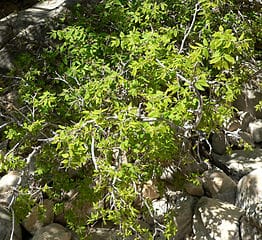 Photo: Stan Shep 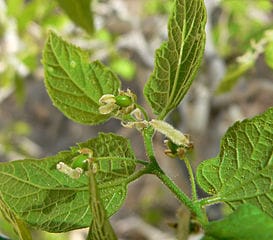 Photo: Stan Shep |  Netleaf Hackberry, Palo BlancoCELAR (Celtis reticulata)Family: Cannabaceae (Hemps, Hops, and Hackberries) Size: 20 - 30 ft (10 - 10 m) Growth: shrub, tree; perennial Status: native; common Habitat: areas with a constant water supply at less than 7,500 ft (2,700 m) Bark is grey-brown with vertical corky ridges that is checkered between the furrows. It produces an edible fruit. Info Photos Range Distribution |
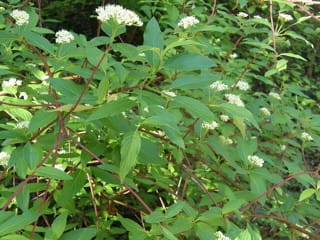 Photo: Chick Keller 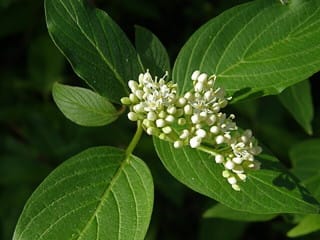 Photo: Chick Keller |  Red Osier DogwoodCOSE16 (Cornus sericea)Family: Cornaceae (Dogwoods) Size: 3 - 10 ft (1 - 3 m) Growth: shrub, tree; perennial Status: native; uncommon Habitat: wet canyons not too far from a stream at elevations up to 9,000 ft (2,800 m) Primarily a large, spreading shrub that often forms thickets. It has small white flowers and a small whitish fruit. Twigs are reddish in color and resemble those of osier willows for which the plant is named. Info Photos Range Distribution Flower Guide |
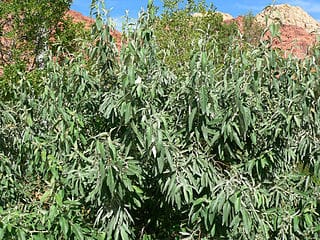 Photo: Stan Shebs 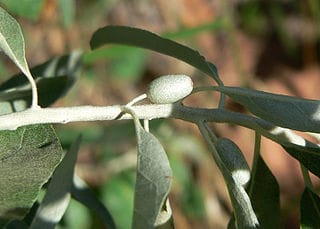 Photo: Stan Shebs |  Russian Olive, Russian SilverberryELAN (Elaeagnus angustifolia)Family: Elaeagnaceae (Oleasters) Size: 15 - 23 ft (5 - 10 m) Growth: shrub, tree; perennial Status: invasive; common Habitat: thrives in riparian areas This invasive species is similar in appearance to a true olive tree but not related. Usually a thorny shrub or small tree. Stems, buds and leaves have a dense covering of silvery-to-rusty scales. Fruits are edible and sweet but usually dry and mealy. Birds like the fruit and spread the seeds. Info Photos Range Weed Plant Guide |
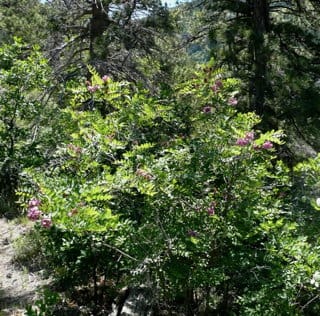 Photo: Charlie McDonald - USDA Forest Service 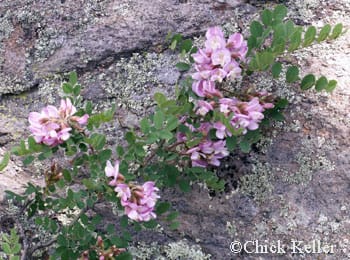 Photo: Chick Keller |  New Mexican Locust, Mescal BeanRONE (Robinia neomexicana)Family: Fabaceae (Peas) Size: up to 25 ft (10 m) Growth: shrub, tree; perennial Status: native; common Habitat: deserts, mesa, canyons, and conifer forests at elevations of 4,500 to 8,000 ft (1,200 to 2,600 m) Spiny shrub or small tree that often forms thickets. The bark is slightly gray with furrowed scaly ridges. Showy flowers appear in spring and early summer in large, drooping clusters. The fruits are brown bean-like pods with bristles. It is among the first woody plants to grow after wildfires but is soon shaded out by taller trees. Like many members of the pea family, New Mexico Locust has a symbiotic relationship with nitrogen-fixing bacteria that live in nodules in the plant’s roots. Info Photos Range Distribution Flower Guide |
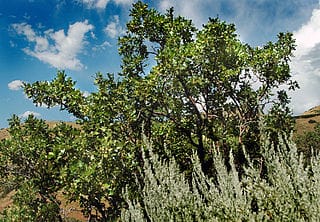 Photo: Cory Maylett 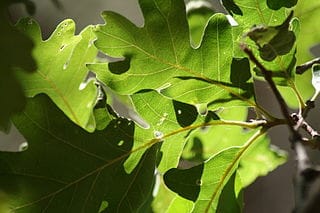 Photo: Quinn Dombrowski |  Gambel Oak, Rocky Mountain White OakQUGA (Quercus gambelii)Family: Fagaceae ( Beeches and Oaks) Size: 20 - 70 ft (10 - 25 m) Growth: shrub, tree; perennial Status: native; common Habitat: slopes and in valleys, often scattered among ponderosas at elevations from 5,000 to 8,000 ft (1,500 to 2,400 m) The foliage is browsed by deer while the sweetish acorns are eaten by a variety of wildlife. Gambel Oak regenerates vegetatively from a massive underground system called a lignotuber. This species hybridizes with at least six other oak species. The hybrids (often called 'Waveyleaf Oak' or 'Quercus X undulata') typically have shallow leaf lobes; the leaves are often semideciduous, many staying on the tree over the winter. Info Photos Range Distribution |
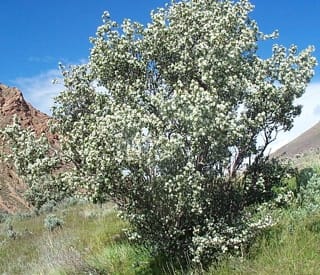 Photo: Tony Frates 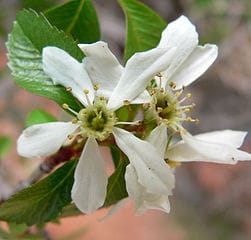 Photo: Stan Shebs 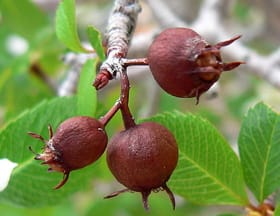 Photo: Stan Shebs |  Utah ServiceberryAMUT (Amelanchier utahensis)Family: Rosaceae ( Roses) Size: up to 10 ft (3 m) Growth: shrub, tree; perennial Status: native; common Habitat: scrubby open slopes to woodlands and forests The Utah Serviceberry is a spreading plant bearing rounded or spade-shaped, often toothed leaves. It has showy white flowers. Serviceberries can reproduce asexually through various genetic mechanisms (apomixis, polyploidy). The self-perpetuating local lineages—microspecies—that result can hybridize with each other and produce a bewildering mosaic of variations. Info Photos Range Distribution |
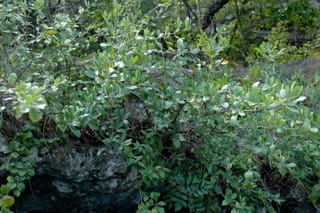 Photo: nancyed 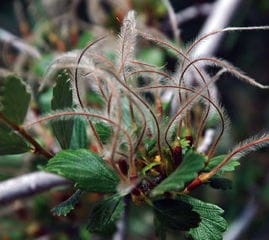 Photo: Cory Maylett |  Mountain Mahogany, Silverleaf, Alderleaf Mountain MahoganyCEMO2 (Cercocarpus montanus)Family: Rosaceae (Roses) Size: 8 - 20 ft (2 - 6 m) Growth: shrub, tree; perennial Status: native; common Habitat: dry rocky hillsides, cliffs, open woods, mesas at eleavtions of 3,500 to 8,000 ft (1,100 to 2,400 m) This shrub or small tree has leaves that are dark-green leaves on top and fuzzy underneath and remain on the tree for most of the year. Non-showy flowers are followed by feathery, silvery-white fruits during the summer and fall. Info Photos Range Flower Guide |
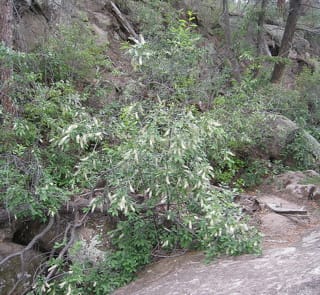 Photo: Jennifer Macke 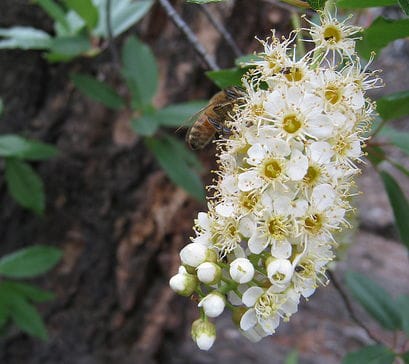 Photo: Jennifer Macke 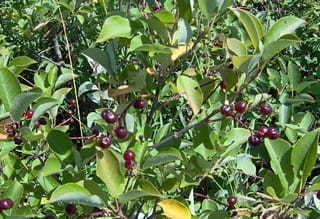 Photo: SriMesh |  Common ChokecherryPRVI (Prunus virginiana)Family: Rosaceae (Roses) Size: 6 - 20 ft (2 - 6 m) Growth: shrub, tree; perennial Status: native; common Habitat: fields, mountains, along fresh water at elevations up to 8,000 ft (2,400 m) Can form dense thickets producing dark red to blackish berries. The bark and leaves are poisonous, particularly in early spring; the astringent fruit can be used for jams and jellies. Info Photos Range Distribution Flower Guide |
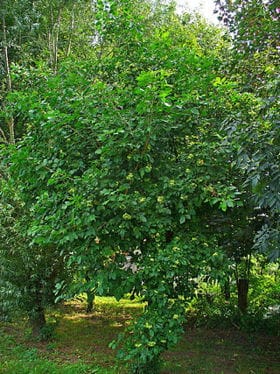 Photo: H. Zell 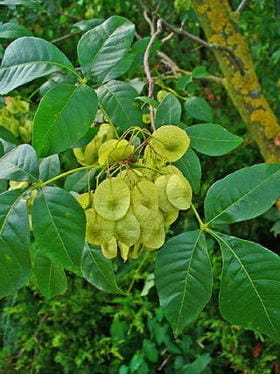 Photo: H. Zell |  Common Hoptree, Wafer AshPTTR (Ptelea trifoliata)Family: Rutaceae (Citrus) Size: up to 20 ft (10 m) Growth: shrub, tree; perennial Status: native; common Habitat: dry rocky uplands at elevations up to 8,500 ft (2,600 m) The northern-most representative of the citrus family. The name refers to reported use of the bitter fruit as a substitute for hops in beer. Its 3-part leaves resemble the leaves of Poison Ivy and Western Poison Oak, which can cause severe contact dermatitis. Poison Ivy and Poison Oak have 3-parted leaves with margins that are toothed or scalloped and often lobed; their fruits are brownish or whitish berries. In contrast, the Common Hoptree has smooth-edged leaves and produces flat wafer-like seed pods. Avoid contact if you are uncertain about its identification. Info Photos Range Distribution |
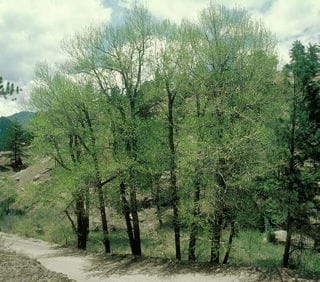 Photo: Matt Lavin 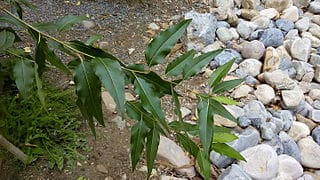 Photo: HoHey22 |  Narrowleaf Cottonwood, Willow-leaved PoplarPOAN3 (Populus angustifolia)Family: Salicaceae (Willows) Size: up to 75 ft (25 m) Growth: tree; perennial Status: native; common Habitat: moist soils along streams in mountains along with other deciduous trees at elevations of 3,000 to 8,000 ft (900 to 2,400 m) Has large, resinous and fragrant leaf buds. Its seeds are fluffy and are spread via wind. Info Photos Range Distribution |
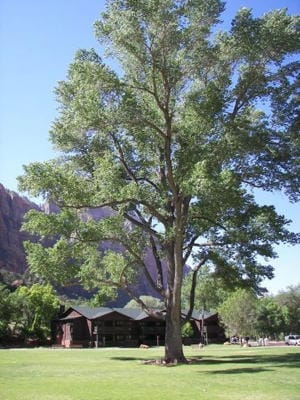 Photo: Amy Gaiennie 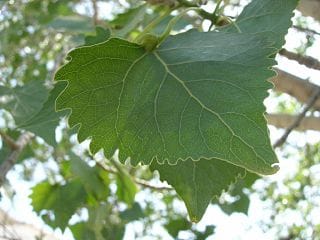 Photo: Joe Decruyenaere |  Freemont CottonwoodPOFR2 (Populus fremontii)Family: Salicaceae (Willows) Size: 40 - 80 ft (15 - 25 m) Growth: tree; perennial Status: native; common Habitat: wet soil along streams at elevations up to 6,500 ft (2,000 m) Common at lower altitudes. Parasitic mistletoe is often scattered in the branches. Very similar to Populus deltoides (Eastern or Rio Grande Cottonwood), most easily distinguished by range. Info Photos Range Distribution |
_02.jpg) Photo: Tewy 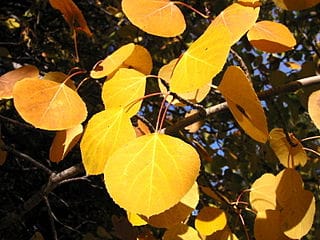 Photo: Walter Siegmund |  Quaking Aspen, American Aspen, Mountain AspenPOTR5 (Populus tremuloides)Family: Salicaceae (Willows) Size: 66 - 82 ft (20 - 25 m) Growth: tree; perennial Status: native; common Habitat: areas with sandy or gravelly slopes at elevations below spruce-firs --- 6,500 to 10,000 ft (2,000 to 3,000 m) This short-lived, tall tree reproduces rapidly from seed and root suckers leading to growth in clumps. Quaking Aspen is the most widely distributed tree in North America. A grove of Quaking Aspen is often a single organism: a clone with all tree stems arising from a common root system. Clones may be large or small. In autumn, differences between clones often show as differences in leaf color and different times of leaf fall. One male clone in the Wasatch Range in Utah covers about 107 acres, has 47,000 trunks, and is often considered the world’s most massive organism. It is estimated to be 80,000 years old, possibly the oldest living thing on Earth. This clone is called Pando. Info Photos Range Distribution |
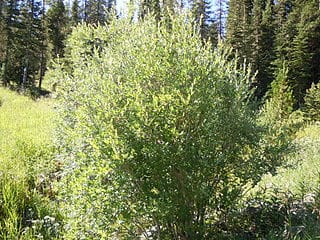 Photo: Matt Lavin 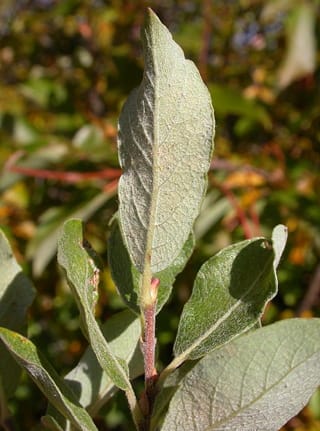 Photo: Matt Lavin |  Bebb Willow, Long-beaked WillowSABE2 (Salix bebbiana)Family: Salicaceae (Willows) Size: 10 - 25 ft (3 - 8 m) Growth: shrub, tree; perennial Status: native; common Habitat: wet lowlands, lake and stream edges, and drier upland sites at elevations up to 11,000 ft (3,400 m) This narrow, somewhat columnar-shaped plant has maroon bark. It is fast-growing shrubby tree and prefers loose, wet soil. The twigs and branches are used by Native Americans for weaving. Info Photos Range Distribution |
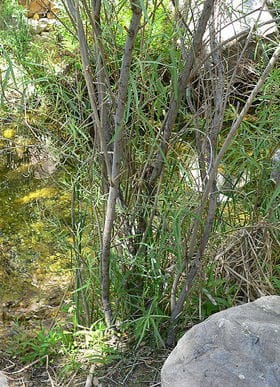 Photo: Stan Sheb 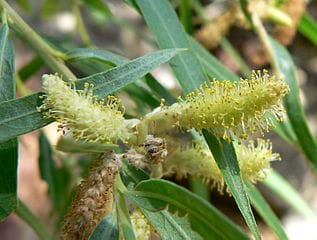 Photo: Stan Sheb |  Sandbar Willow, Narrowleaf Willow, Coyote WillowSAEX (Salix exigua)Family: Salicaceae (Willows) Size: 3 - 10 ft (1 - 3 m) Growth: shrub, tree; perennial Status: naturalized plant; common Habitat: wet soils, especially along riverbanks at elevations up to 8,000 ft (2,500 m) Native to Western and Central Asia but was introduced to North America some time before 1900. Commonly forms thickets with clustered stems as a shrub. Livestock often browse the foliage. Info Photos Range Distribution |
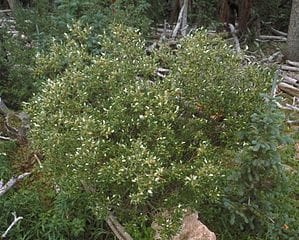 Photo: Dave Powell 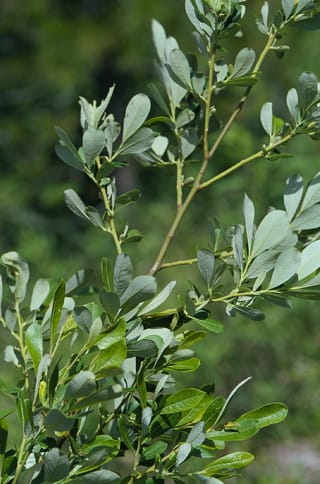 Photo: Matt Lavin |  Scouler WillowSASC (Salix scouleriana)Family: Salicaceae (Willows) Size: 15 - 50 ft (5 - 15 m) Growth: shrub, tree; perennial Status: native; common Habitat: upland forests under larger trees and in dry clearings at elevations up to 10,000 ft (3,000 m) Grows as a shrub or small tree with an erect trunk and rounded crown. It rapidly occupies burned areas forming thickets. Info Photos Range Distribution |
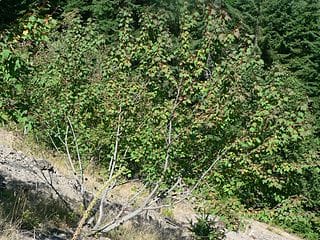 Photo: Walter Siegmund 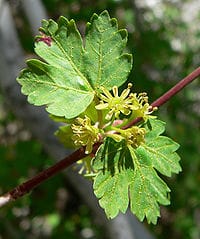 Photo: Stan Sheps  Photo: Walter Siegmund |  Rocky Mountain MapleACGL (Acer glabrum)Family: Sapindaceae (Soapberries) Size: up to 30 ft (10 m) Growth: shrub, tree; perennial Status: native; common Habitat: moist soils, especially in canyons and on slopes at elevations of 5,000 to 9,000 (1,500 to 2,800 m) Leaves usually have three short-pointed lobes with long reddish leafstalks. The fruit is often browsed by elk, deer and birds. Info Photos Range Distribution |
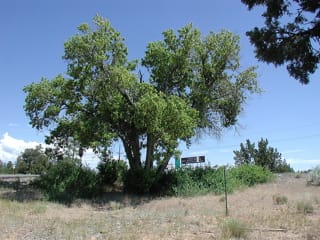 Photo: Dorothy Hoard 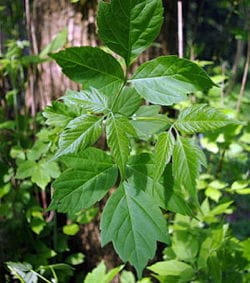 Photo: Chrumps |  Box Elder, Ash-leaf Maple, Three-Leaf MapleACNE2 (Acer negundo)Family: Sapindaceae (Soapberries) Size: 30 - 60 ft (10 - 20 m) Growth: tree; perennial Status: native; common Habitat: areas with ample water up to 8,000 ft (2,400 m) Several trunks can form dense thickets. Winged fruit attracts birds and squirrels. Info Photos Range Distribution |
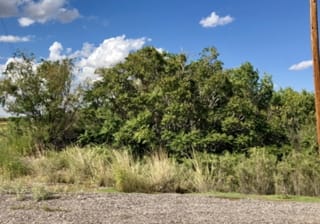 Photo: CK Kelly 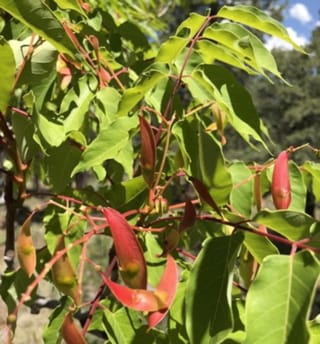 Photo: lesbrandt |  Tree of HeavenAIAL (Ailanthus altissima)Family: Simaroubaceae (Quassia) Size: up to 80 ft (25 m) Growth: tree; perennial Status: invasive; common Habitat: disturbed soil, sunny areas, gardens This tree was brought to the US in the 1780s and was initially considered to be a beautiful garden specimen. However it fell out of favor with time, due to its suckering habit and foul smell. Info Photos Range Distribution Weed Guide |
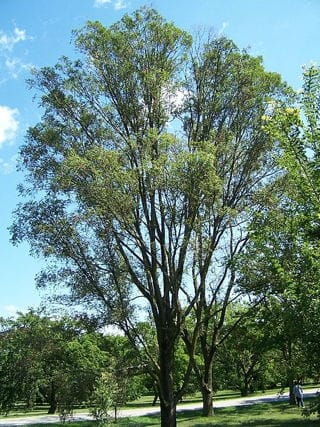 Photo: Bruce Marlin 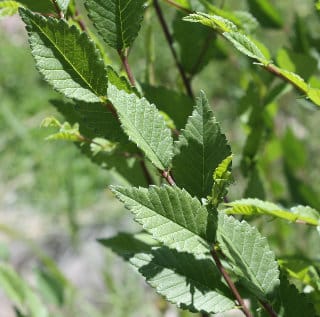 Photo: Akkana Peck |  Siberian Elm, Dwarf ElmULPU (Ulmus pumila)Family: Ulmaceae (Elms) Size: 50 - 70 ft (15 - 25 m) Growth: shrub, tree; perennial Status: invasive; common Habitat: canyons and open areas Native of Central Asia but now has spread throughout the US after its introduction in the 1860s. Can be a pretty tree with saw-toothed leaves, greenish flowers and winged fruit but it spreads so aggressively that it is generally considered invasive in many areas including our own. Info Photos Range Weed Guide |
